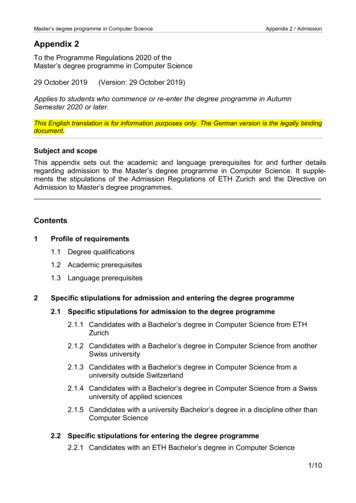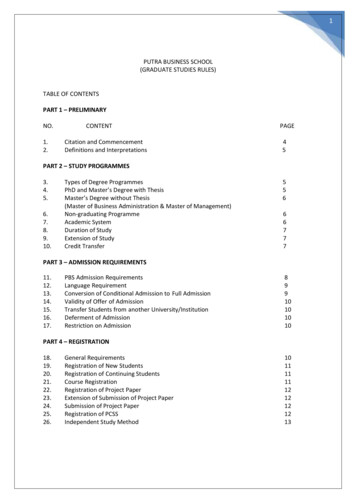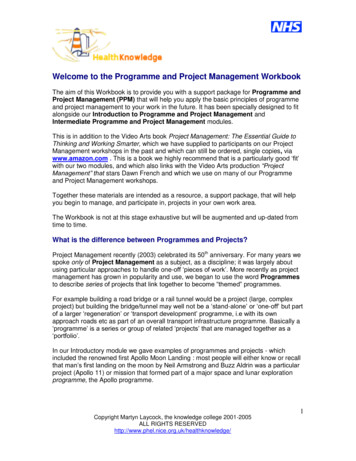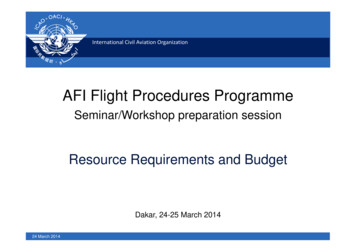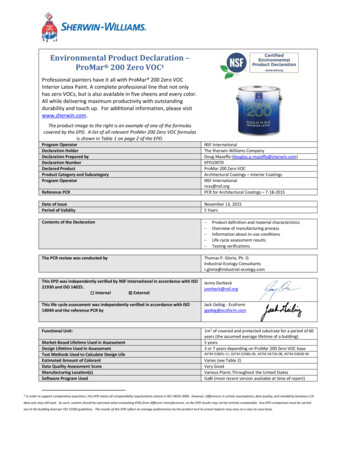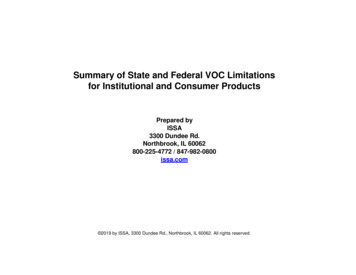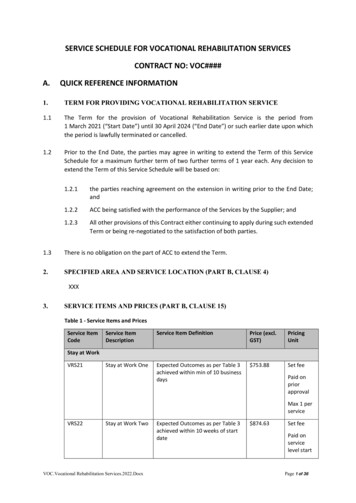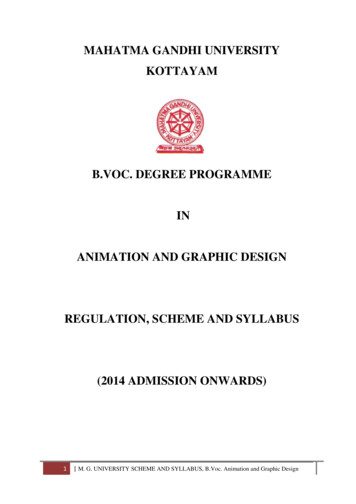
Transcription
MAHATMA GANDHI UNIVERSITYKOTTAYAMB.VOC. DEGREE PROGRAMMEINANIMATION AND GRAPHIC DESIGNREGULATION, SCHEME AND SYLLABUS(2014 ADMISSION ONWARDS)1 M. G. UNIVERSITY SCHEME AND SYLLABUS, B.Voc. Animation and Graphic Design
SCHEME AND SYLLABUS FORB.VOC. ANIMATION AND GRAPHIC DESIGN(To be introduced from 2014 admissions)The University Grants Commission (UGC) has launched a scheme on skills development basedhigher education as part of college/university education, leading to Bachelor of Vocation (B.Voc.)Degree with multiple exits such as Diploma/Advanced Diploma under the NSQF (National skillQualifications framework). The B.Voc. programme is focused on universities and colleges providingundergraduate studies which would also incorporate specific job roles along with broad based generaleducation. This would enable the graduates completing B.Voc. to make a meaningful participation inaccelerating India’s economy by gaining appropriate employment, becoming entrepreneurs and creatingappropriate knowledge.The proposed vocational programme in Animation and Graphic Design will be a judicious mix of skills,professional education related to Animation and Graphic Design and also appropriate content of generaleducation. It is designed with the objective of equipping the students to cope with the emerging trendsand challenges in the field of Animation and Graphic Design.ELIGIBILITY FOR ADMISSIONA pass in Plus Two or equivalent examination or an examination recognized as equivalent thereto by thisUniversity.CURRICULUMThe curriculum in each of the years of the programme would be a suitable mix of general education andskill development components.DURATIONThe duration of the B. Voc. Animation and Graphic Design shall be three years consisting of sixsemesters. The duration of each semester shall be five months inclusive of the days of examinations.There shall be at least 90 working days in a semester.ELIGIBILITY FOR HIGHER STUDIESThose who pass B.Voc. Animation and Graphic Design Degree are eligible for admission to higherstudies. While applying for higher studies, B. Voc. (Animation and Graphic Design) is consideredequivalent to B.A. Animation and Graphic Design of M.G. University.PROGRAMME STRUCTUREThe B.Voc. Animation and Graphic Design shall include: General Education Components Skill Components Project Internship Soft Skills and Personality Development Programmes2 M. G. UNIVERSITY SCHEME AND SYLLABUS, B.Voc. Animation and Graphic Design
CREDIT CALCULATIONThe following formula is used for conversion of time into credit hours.One Credit would mean equivalent of 15 periods of 60 minutes each, for theory, workshops/labs and tutorials;For internship/field work, the credit weightage for equivalent hours shall be 50% of that for lectures/workshops;COURSE STRUCTURENSQFLevelSkill ComponentCreditsGeneral ComponentCreditsNormalDurationExit Points / AwardsYear 33624Six SemestersB. Voc.Year 23624Four SemestersAdvanced DiplomaYear 13624Two SemestersDiplomaAs per the UGC guidelines, there are multiple exit points for a candidate admitted in this course.If he/she is completing all the six credits successfully, he/she will get B. Voc. Degree in Animation andGraphic Design. If he/she is completing the first four semesters successfully, he/she will get anAdvanced Diploma in Animation and Graphic Design. If he/she is completing the first two semesterssuccessfully, he/she will get a Diploma in Animation and Graphic Design. Animation and GraphicDesign B.Voc. Degree holder is expected to acquire the skills needed for an Animation and GraphicDesigner.PROGRAMME STRUCTURESemester - ISl.No.CourseCodeTitleGC/SC Hrs/Week Credits1AGDG101Listening and Speaking Skills in EnglishGC452AGDG102Fundamentals of ComputersGC453AGDG103Basics of Drawing(AOC)GC454AGDS104Elements of Visual Design (AOC)SC455AGDS105Raster and Vector Graphics (AOC)SC556AGDS106Graphic Design LabSC453 M. G. UNIVERSITY SCHEME AND SYLLABUS, B.Voc. Animation and Graphic Design
Semester - IISl.No. Course Code TitleGC/SCHrs/WeekCredits1AGDG201Writing and Presentation Skills in EnglishGC552AGDG202Media OrganizationGC553AGDS203HTML & Web Technologies (AOC)SC554AGDS204Publication Design (AOC)SC555AGDS205Web Design Lab (AOC)SC556AGDS206Internship - ISC5Semester - IIISl.No.CourseCode1AGDG301Fundamentals of Animation (T)GC452AGDG302Digital Photography (AOC)GC453AGDG303Drawing for Animation - I (AOC)SC454AGDS304Drawing for Animation - II (AOC)SC455AGDS305Script Writing And Storyboarding For Animation(AOC)SC556AGDS306BG Design For Cel Animation (AOC)SC45TitleGC/SCHrs/Week CreditsSemester - IVSl.No.CourseCode1AGDG401Animation Techniques (AOC)GC552AGDG402Cel Animation - I (AOC)GC553AGDS403Cel Animation - II (AOC)SC554AGDS404Digital 2D Animation (AOC)SC555AGDS405Project - Animation ProjectSC556AGDS406Internship - IISC4TitleGC/SCHrs/Week Credits M. G. UNIVERSITY SCHEME AND SYLLABUS, B.Voc. Animation and Graphic Design5
Semester - VSl.No.CourseCode1AGDG501Media Ethics and EducationGC452AGDG502Elements of 3D Animation (AOC)SC453AGDS503BG and Props Modelling (AOC)SC454AGDS504Character Modelling (AOC)SC455AGDS505Texturing and Rigging (AOC)SC556AGDG506Character Animation (AOC)SC45TitleGC/SCHrs/Week CreditsSemester – VISl.No.CourseCode1AGDG601Soft Skills And Personality DevelopmentGC552AGDS602Lighting and Rendering (AOC)SC553AGDS603Visual Effects And Compositing (AOC)SC554AGDS604Audio And Video Editing Principles (AOC)SC555AGDS605Project – 3D Animation ProjectSC556AGDS606Internship - IIISCTitleGC/SCHrs/Week Credits5GC – General ComponentSC – Skill ComponentATTENDANCEThe minimum number of hours of lectures, tutorials, seminars or practical which a student shall berequired to attend for eligibility to appear at the end semester examination shall not be less than 75 percent of the total number of lectures, tutorials, seminars or practical sessions. Internships, study tours andsoft skill and personality development programmes are part of the course and students must attend inthese activities to complete a semester.5 M. G. UNIVERSITY SCHEME AND SYLLABUS, B.Voc. Animation and Graphic Design
EVALUATION AND GRADINGThe evaluation of each course shall contain two parts:(i) Internal or In-Semester Assessment (ISA)(ii) External or End-Semester Assessment (ESA)The ISA and ESA ratio shall be 1:4 for theory and practicals. There shall be a maximum of 80 marks forESA and maximum of 20 marks for ISA.CRITERIA FOR GRADINGFor all courses (theory & practical), grades are given on a 07-point scale based on the total percentage ofmarks. (ISA ESA) as given belowPercentage ofGradeMarksGrade Point90 and aboveA Outstanding1080-89AExcellent970-79BVery Below 40FFailure4Note1: Decimal are to be rounded to the next whole numberCREDIT POINT AND CREDIT POINT AVERAGECredit Point (CP) of a course is calculated using the formulaCP C x GP, where C Credit; GP Grade pointCredit Point Average (CPA) of a Semester/Programme is calculated using the formulaCPA TCP/TC, where TCP Total Credit Point; TC Total CreditGrades for the different semesters and overall programme are given based on the corresponding CPA asshown below:CPAAbove 9Above 8, but below or equal to 9Above 7, but below or equal to 8Above 6, but below or equal to 7Above 5, but below or equal to 6Above 4, but below or equal to 54 or below6GradeA ABCDEFOutstandingExcellentVery GoodGoodSatisfactoryAdequateFailure M. G. UNIVERSITY SCHEME AND SYLLABUS, B.Voc. Animation and Graphic Design
Note 2: A separate minimum of 30% marks each for internal and external (for both theory and practical)and aggregate minimum of 40% are required for a pass for a course. For a pass in a programme, aseparate minimum of Grade E is required for all the individual courses. If a candidate secures F Gradefor any one of the courses offered in a Semester/Programme only F Grade will be awarded for thatSemester/Programme until he/she improves this to E Grade or above within the permitted period.Candidate who secures E Grade and above will be eligible for higher studies.CONTINUOUS EVALUATION (CE)All records of Continuous Evaluation shall be kept in the Department and shall be made available forverification by the University, if and when DCONTINUOUSEVALUATIONThe external examination of all semesters shall be conducted by the University at the end of eachsemester. Internal evaluation is to be done by continuous assessment.a)Marks of External Examination (Theory / Practical / Project): 80b)Marks of Internal Evaluation (Theory / Practical / Project): 20 Components of Internal Evaluation - TheoryAll the three components of the internal assessment are mandatory. For the course English in I & IISemesters, internal oral examination shall be conducted instead of one test paper.Components of Internal Evaluation - TheoryMarksAttendance5Assignment /Seminar/Viva5Test paper(s) (1 or 2)(1 10 10; 2 5 10)10Total20Attendance:The allotment of marks for attendance shall be as follows:7Attendance PercentageLess than 75 %Marks1 Mark75 % & less than 80%2 Marks80% & less than 85%3 Marks85% & less than 90%4 Marks90% & above5 Marks M. G. UNIVERSITY SCHEME AND SYLLABUS, B.Voc. Animation and Graphic Design
Assignment:Assignments are to be done from 1st to 4th Semesters. At least one assignment should be done in eachsemester.Seminar/Viva:A student shall present a seminar in the 5th semester and appear for Viva-voce in the 6th semester.Internal Assessment Test PapersAt least one internal test-paper is to be attended in each semester for each course. The evaluations of allcomponents are to be published and are to be acknowledged by the candidates. All documents ofinternal assessments are to be kept in the college for two years and shall be made available forverification by the University. The responsibility of evaluating the internal assessment is vested on theteacher(s), who teach the course. Components of Internal Evaluation – PracticalComponents of Internal Evaluation – PracticalMarksAttendance5Record5Test5Performance, Punctuality and Skill5Total20END SEMESTER EVALUATION (ESE):End Semester Evaluation of all the Courses in all the semesters shall be conducted by the University.The results of the ESE shall be arranged to be published according to the Examination Calendarprescribed by the University.PATTERN OF QUESTIONS FOR EXTERNAL EXAMINATION – THEORY PAPERTotal no.Number ofMarks ofofquestions toeachquestionsbe answeredquestionVery short answer type (One word tomaximum of one sentence)1010110Short answer (Not to exceed 60 words)128216Short essay (Not to exceed 120 words)96424Long essay421530TOTAL3526Question Type8Totalmarks80 M. G. UNIVERSITY SCHEME AND SYLLABUS, B.Voc. Animation and Graphic Design
PATTERN OF EVALUATION FOR EXTERNAL EXAMINATION – PRACTICAL /INTERNSHIP WITH PROJECTThe components of End Semester Examination of Practical/Internship /Project have to be set by theChairman, Boards of Studies, concerned.Note 3: Students having a minimum of 75% average attendance for all the courses only can register forthe examination. Condonation of shortage of attendance to a maximum of 10 days or 50 hours in asemester subject to a maximum of two times during the whole period of the programme may be grantedby the University on valid grounds. This condonation shall not be counted for internal assessment.Benefit of attendance may be granted to students attending University/College union/Co-curricularactivities by treating them as present for the days of absence, on production of participation/attendancecertificates, within one week, from competent authorities and endorsed by the Head of the institution.This is limited to a maximum of 10 days per semester and this benefit shall be considered for internalassessment also.Those students who are not eligible even with condonation of shortage of attendanceshall repeat the course along with the next batch.GRIEVANCE REDRESSAL MECHANISMInternal assessment shall not be used as a tool for personal or other type of vengeance. A student has allrights to know, how the teacher arrived at the marks. In order to address the grievance of students athree-level Grievance Redressal mechanism is envisaged. A student can approach the upper level only ifgrievance is not addressed at the lower level.Level 1:Dept. Level: The department cell chaired by the Head, Dept. Coordinator and teacher in-chargeas members.Level 2: College level: A committee with the Principal as Chairman, Dept. Coordinator, HOD ofconcerned Department and a senior teacher nominated by the College council as members.Level 3: University Level: A Committee constituted by the Vice-Chancellor as Chairman, Pro-ViceChancellor, Convener - Syndicate sub-committee on Students Discipline and Welfare, Chairman- Boardof Examinations as members and the Controller of Examination as member-secretary.9 M. G. UNIVERSITY SCHEME AND SYLLABUS, B.Voc. Animation and Graphic Design
B.Voc. in Animation and Graphic DesignDetailed SyllabusSEMESTER – IAGDG101 : LISTENING AND SPEAKING SKILLS IN ENGLISHObjectives: To introduce the students to the speech sounds of English in order to enable them to listento English and speak with global intelligibility. To enable the students to speak English confidently andeffectively in a wide variety of situations. To help the students to improve their reading efficiencyby refining their reading strategies.MODULE – ISpeech Sounds: Phonemic symbols – Vowels – Consonants – Syllables – Word stress – Stressin polysyllabic words – Stress in words used as different parts of speech – Sentence stress –Weak forms and strong forms – IntonationMODULE – IIAccents: Awareness of different accents: American, British and Indian – Influence of themother tongue.MODULE – IIIListening: Active listening – Barriers to listening – Listening and note taking – Listening toannouncements – Listening to news on the radio and television.MODULE– IVSpeaking: Word stress and rhythm – Pauses and sense groups – Falling and rising tones –Fluency and pace of delivery – Art of small talk – Participating in conversations – Making ashort formal speech – Describing people, place, events and things – Group discussion skills andtelephone skills.MODULE – VReading: Theory and Practice – Scanning – Surveying a textbook using an index – reading witha purpose – Making predictions – Understanding text structure – Locating main points –Making inferences – Reading graphics – Reading critically – Reading for research.Books for ReferenceV.Sasikumar, P KiranmaiDutt and GeethaRajeevan, .Communication Skills in English.Cambridge University Press and Mahatma Gandhi University.FURTHER READING1. A Course in Listening and Speaking I & II, Sasikumar, V.,KiranmaiDutt andGeethaRajeevan, New Delhi: CUP, 20072. Study Listening: A Course in Listening to Lectures and Note-taking Tony Lynch NewDelhi: CUP,10 M. G. UNIVERSITY SCHEME AND SYLLABUS, B.Voc. Animation and Graphic Design
3. Study Speaking: A Course in Spoken English for Academic Purposes. Anderson,Kenneth, Joan New Delhi: OUP, 20084. Study Reading: A Course in Reading Skills for Academic Purposes, Glendinning, EricH. and Beverly Holmstrom New Delhi: CUP, 20085. Communication Studies. Sky Massan Palgrave, Macmillan. Effective Communication forArts and Humanities Students Joan Van Emden and Lucinda Becker PalgraveMacmillan6. Effective Communication for Arts and Humanities Students Joan Van Emden andLucinda Becker Palgrave Macmillan.11 M. G. UNIVERSITY SCHEME AND SYLLABUS, B.Voc. Animation and Graphic Design
SEMESTER – IAGDG102: FUNDAMENTALS OF COMPUTERSObjectives: To achieve a thorough understanding about a computer system Internet.Module – IIntroduction: Parts of Computer System- Hardware, Software, Data, Users, Different types ofcomputers, Characteristics of computers, Computer Languages - Machine, Assembly Languageand Higher Level languages - 3GL, 4GL, 5GL.Module – IIInteracting with Computers: Input/Output devices: Printers: Dot matrix, Inkjet, Laser ,Keyboards-switches, working, connectors/interfaces, Pointing and positioning devices – types,construction & working, wireless input devices, Digital camera, Scanner-types, Monitor types.Module – IIIData Processing: Representation of data, processing of data - The CPU, Memory-differenttypes of RAM and ROM, Factors affecting speed.Module – IVStoring Information in a Computer: Types of Storage Devices - Magnetic Storage DevicesData storage and organization on a Magnetic Disk, Finding data on a disk -Diskettes - HardDisks- Tape drives- Optical Storage devices ,Solid state storage devices.Module – VInternet: Introduction to World Wide Web, Internet operations, Introduction to ElectronicCommerce and Electronic Business.Books for Reference1. Peter Norton’s Introduction to Computers, Sixth Edition, Published by Tata McGrawHill2. Computer Fundamentals By P K Sinha & Priti Sinha Fourth Edition.3. Introduction to Computer Science, ITL Education Solutions limited.12 M. G. UNIVERSITY SCHEME AND SYLLABUS, B.Voc. Animation and Graphic Design
SEMESTER – IAGDG103: BASICS OF DRAWING (AOC)Objectives: This course is intended to provide the student a basic understanding of drawingtechniques. Students develop a basic skill in drawing through various exercises. This coursealso helps the students to have an idea about the history of art in general.MODULE – IA Brief History Of Art and Drawing: – Cavemen, Classical Art, Renaissance, Modern Art Etc.MODULE – IIIntroduction Of Different Drawing Materials And Tools - Dry Media – (Pencils, Charcoals,Chalks, Crayons – Pastels, Erasers, Smudging Tools) - Wet Media – (Dip Pens, Disposable AndCartridge Pens) – Markers – Brushes – Inks (Water Based, Alcohol Based, Indian/Chinese Ink)– Paints (Water Based, Acrylic, Oil)MODULE – IIIDrawing Surfaces – (Papers – Newsprint – Vellum - Bristol Board - Rag/Cotton Paper Watercolor Paper - Charcoal Paper - Colored Paper - Rice Paper – How To Handle ThesePapers) - Other Drawing Surfaces – (Scratchboards) - Tools For Erasing And Sharpening –Palettes – Knives- Easels .MODULE– IVDrawing Lines, Circles, Ovals, Scribbles, Patterns Etc. - Drawing From Observation, DoodlingAnd Noodling – Drawing Straight Lines –Free Hand Drawing – Holding The Pencil – AngleAnd Direction Of Lines - Shapes And Forms – Drawing With GridsMODULE – VBasic Elements And Principles In Picture Composition – Line – Color – Value – Shape – Form–Space – Texture – Balance – Emphasis – Contrast – Rhythm And Movement – Pattern AndRepetition – Unity – Variety – Proportion - Basic Geometric Shapes And Forms Compositional Techniques - Rule Of Thirds - Rule Of Odds - Rule Of Space – Simplification.Books for Reference1. Social History Of Art : Arnold Hauser2. Encyclopaedia Of World Art (Vol.I&II): Mcgraw Hill Publication3. The Art Of Pictorial Composition : Wolehonok4. Exploring The Elements Of Design : Mark A. Thomas, Poppy Evans5. The Art Of Composition : Michael Jacobs6. The Art Of Pictorial Composition : Wolehonok7. Complete Books Of Artist Techniques : Dr. Kurt Herbers8. Drawing For The Absolute And Utter Beginner: Claire Watson Garcia13 M. G. UNIVERSITY SCHEME AND SYLLABUS, B.Voc. Animation and Graphic Design
SEMESTER – IAGDS104: ELEMENTS OF VISUAL DESIGN (AOC)Objectives: The objective of this course is to introduce the elements and basic principles ofvisual design. The elements form the 'vocabulary' of the design, while the principles constitutethe broader structural aspects of its composition.MODULE – IIntroduction To Basic Elements Of Visual Design: Line– Line Direction And Meanings-QualityOf Lines-Implied Lines And Line Of Force, Shape- Organic Shape And Geometric Shapes-NonRepresentational Shape And Representational Shape, Forms-Relationship With 2d Shape And3d Forms, Space –Negative Space And Positive Space-Figure/Ground Relation, ColourSubtractive And Additive Colour-Primary, Secondary In Both Modes- Colour Wheel-WhatIsHue, Saturation And Value- What Is Shade, Tint And Tones-Colour Schemes –Monochromatic, Analogous,Complementary, Split Complementary, Triadic Colour,DoubleComplementary Etc-Colour Meaning In Various Context Such As Culture, Religion, GenderAnd Emotional Factor, Texture – Visual Texture And Tactile Texture, Texture And LightValue, PatternMODULE – IITypography - Typeface, Typeface Family, Font, Anatomy Of Type, Typographic Measurement– Point And Pica, Text Type And Display Type, Classification Of Type - Old Style,Transitional Period, Modern, Slab Serif, Sans Serif, Script, Decorative Etc. Selection Of A TypeFace In Design-Clarity: Readability And Legibility, Integration With Visuals, Concept AndTheme EtcMODULE – IIIBasic Principles Of Design: Balance, Proportion, Rhythm, Emphasis, Unity Etc. Laws OfPerceptual Action: Similarity, Proximity, Continuity, Closure Etc. Scale And Proportion InDesign-Mathematical Ratios And Proportional Systems: Fibonacci Numbers, Golden Ratio.MODULE– IVExercises On Visual Composition And Layout. The Use Of Grids In GraphicsComposition.Concepts Of Visual Design, Visual Structure And Visual Interest, Visual AnalysisAnd Refinement Of Visual Representations.MODULE– VProblem Solving- Tessellation Exercise With Various Shapes And Colour Schemes, LogoDesign, Poster Design ProjectsBooks for Reference1. Exploring The Elements Of Design : Poppy Evans, Mark A Thomas2. Graphic Design Solutions: Robin Landa3. The Fundamentals Of Typography: Ambrose, Harris14 M. G. UNIVERSITY SCHEME AND SYLLABUS, B.Voc. Animation and Graphic Design
4. Colour Management: John T Draw, Sarah A M15 M. G. UNIVERSITY SCHEME AND SYLLABUS, B.Voc. Animation and Graphic Design
SEMESTER – IAGDS105: RASTER AND VECTOR GRAPHICS (AOC)Objectives: This course introduces students to imaging softwares –The basic tools andtechniques are learned through a series of practical assignments.MODULE – IIntroduction To Raster Images – Image Resolution – RGB, CMYK, Lab And Other ColourModes / Channels And Their Applications –Colour Palate And Swatches .Basic Drawing–Using Airbrush, Pencil, Paint Brush Tools. Concept Of Layers – Transparency And BlendingModes – Creative Use Of Layers And Blending Modes, Layer Mask. Selection Tools-PathOptions And Selection-Alpha Channel, Type Tool And Its Properties. Concept OfGIFAnimation, Image Compression: LossyAnd Lossless Compression FormatsMODULE – IIPhoto Restoration Technique- Clone Tool, Patch Tool, Sponge Tool, Burn Tool, Dodge ToolEtc. Adjusting Hue Saturation And Value, Use Of Levels And Curves, Use Of ColourHistogram, Treatment Of RAW Files, HDR Toning.MODULE – IIIIntroduction To Vector Graphic-What Is Vector, Properties Of Vector Graphics - Stroke AndFill Tools – Basic Shapes, Bezier Drawing With The Pen Tool - CreativeUse Of Shapes –Using The Pathfinder – Boolean Operations Using Shapes - Concept Of 3D Shapes. VectorDrawing Techniques – Node Editing – Tracing From Raster Images – Different Styles OfVector Illustrations. Using Colour In Vector Graphics – Different Colour Palettes – GradientsAnd Gradient Mesh.MODULE – IVUsing Type Tools And Type Controls – Type Along A Path –Concept Of Alignment And TextFlow Options, Filters And Effects.MODULE – VA Design Project Based On Combination Of Raster And Vector Softwares.REFERENCE1. Adobe Photoshop Classroom In A Book:Adobe Creative Team2. Adobe Illustrator Classroom In A Book:Adobe Creative Team3. Beyond Photoshop: Derek Lea4. Adobe Digital Imaging How-Tos: Dan Moughamian5. Crafting Digital Media:Daniel James6. GIMP Essential Reference:Alex Harfor7. Inkscape Guide To A Vector Drawing Program: Tavmjong Bah16 M. G. UNIVERSITY SCHEME AND SYLLABUS, B.Voc. Animation and Graphic Design
SEMESTER – IAGDS106: GRAPHIC DESIGN LABObjectives: This course is mentioned for digital designing of print and digital media. Studentswill explore various techniques for image manipulation, effective colour correction and variousillustrating and design skills.MODULE – IDesign Basics: Measurements-Absolute And Relative. Standard Sizes: Paper Sizes-Book AndPoster Sizes-Screen Sizes Etc. Page Layout: Working Of A Grid System- Column, Margin,Gutter Spaces, Bleed, Registration And Trim. Paper: Paper Qualities, Paper Types And PrintQuality. Binding/Folding: Type Of Binding, Type Of Fold.MODULE – IIDesign Based On Raster Graphics: Poster Design, Advertisement Design, TypographicallyProminent Designs, DesignBook Cover-Understanding Spine, Flap Etc. Design For A Firm:Envelope - Letterhead-Visiting Cards Etc. Design Brochure: Various Type Of FoldingMODULE – IIIImage Restoration And Correction: Image Restoration With Restoration Tools And CorrectionWith Blending Options, Colour Correction-Various Colour Modes: RGB, CMYK, GrayEtcChanging One Mode To Another-Working With Bits/Channel –Understanding Gray Scale,Monotone, Duotone, Triton, Quadtone Etc. Working With Lab Colour Mode. Levels, Curves,HDR Toning, Working With Digital Negative OrRAW File Etc.MODULE– IVDesigns Based On Vector Graphics: Logo And Corporate Identity Design, Symbols Or IconsDesigns For Various Environments Like Schools, Forest, Factory Etc. Digital Illustrations:Botanical Illustration, Scientific Illustrations, Character Illustration Etc.MODULE – VDesignProject – Corporate Style Guide, Information Design EtcBooks for Reference1.The Production Manual: AmbroseHarris2.Design Elements, A Graphical Style Manual:17Timothy Samara M. G. UNIVERSITY SCHEME AND SYLLABUS, B.Voc. Animation and Graphic Design
SEMESTER – IIAGDG201: WRITING AND PRESENTATION SKILLS IN ENGLISHObjectives: To make the students aware of the fundamental concepts of critical reasoning andto enable them to read and respond critically, drawing conclusions, generalizing, differentiatingfact from opinion and creating their own arguments. To assist the students in developingappropriate and impressive writing styles for various contexts. To help students rectifystructural imperfections and to edit what they have written. To equip students for makingacademic presentations effectively and impressively.MODULE – ICritical Thinking: Introduction to critical thinking – Benefits - Barriers – Reasoning Arguments - Deductive and inductive arguments – Fallacies - Inferential comprehensionCritical thinking in academic writing - Clarity - Accuracy – Precision – Relevance.MODULE – IIResearch for Academic Writing and the Writing Process: Data collection - Use of print,electronic sources and digital sources - Selecting key points - Note making, paraphrasing,summary – Documentation - Plagiarism – Title – Body paragraphs - Introduction andconclusion – Revising - Proof-reading.MODULE – IIIAccuracy in Academic Writing: Articles - Nouns and prepositions - Subject-verb agreement Phrasal verbs - Modals - Tenses - Condition-als – Prefixes and suffixes – Prepositions Adverbs – Relative pronouns - Passives - Conjunctions - Em-bedded questions - Punctuation –Abbreviations.MODULE – IVWriting Models: Letters - Letters to the editor - Resume and covering letters - e-mail - Seminarpapers - Project reports - Notices - Filling application forms - Minutes, agenda – Essays.MODULE – VPresentation Skills: Soft skills for academic presentations - Effective communication skills –Structuring the presentation - Choosing appropriate medium – Flip charts – OHP – Power Pointpresentation – Clarity and brevity - Inter-action and persuasion - Interview skills – GroupDiscussions.Books for Reference:Marilyn Anderson, Pramod K Nayar and Madhucchandra Sen. Critical Thinking,Academic Writing and Presentation Skills. Pearson Education and Mahatma GandhiUniversity.18 M. G. UNIVERSITY SCHEME AND SYLLABUS, B.Voc. Animation and Graphic Design
SEMESTER – IIAGDG202: MEDIA ORGANIZATIONObjectives: To make the students aware of the nature and structure of different types of mediaorganizations, media organization’s behavior, relationship between suppliers and buyers andthe economics of the media organization.MODULE – IMedia Organization and Design: Some Conceptual Issues. Media as Business and SocialInstitution. Media enterpreneurship, Greiner's Development Model of a company.MODULE – IIBehavior in media Organization and Organizational Behavior. Nature and Structure of differentMedia Organizations-AIR/DD, Private Satellite Channels, Production Houses, employmentopportunities in Indian Media industry, Group Behavior, Innovation and Creativity, Culture oforganization.MODULE – IIIEconomics of Media-Relationship between supplier and buyer, Leisure time activity, CostFactors, Revenue Models, Market Factors, State of the Industry today.MODULE – IVProject Management in Media-Production Project Cycle (PPC), Management themes inproduction Process, Project Planning, Production Strategies, PPC in Practice-Initiation (Ideas,Evaluation and Assessment), Risk and Impact Assessment, Pre-production, Production Team,Project Specification, Project work plan, Sources of Funds, Budgeting (tols etc.) ProjectResponsibility, Production Process (status Report, Assessment, Negotiation, Completion,Follow-up.MODULE – VProgramming Strategies, Audience Rating-Analyzing Programming and Audience TrendsMarketing Programs arid selling space and time. Different kinds of contracts and legalarrangements, Project Management.Books for Reference:1. Block et al. Managing in the Media. Focal Press, 20012. Media organisation and production, Simon CottleS19 M. G. UNIVERSITY SCHEME AND SYLLABUS, B.Voc. Animation and Graphic Design
SEMESTER – IIAGDS203: HTML & WEB TECHNOLOGIES (AOC)Objectives: Students are introduced to web designing techniques and technologies as they learnhow to create basic web project and also gives students an understanding of how the study ofhuman-computer interaction affects the design of interactive systems.MODULE – IStudy Of Interactive Media – Growth And Development. Principles Of Interaction Design –Anticipation, Consistency, Metaphors, Accessibility, Typography, Navigation. Study Of WebBased Interfaces, In
The B.Voc. programme is focused on universities and colleges providing . 4 AGDS404 Digital 2D Animation (AOC) SC 5 5 5 AGDS405 Project - Animation Project SC 5 5 6 AGDS406 Internship - II SC 5 . 5 M. G. UNIVERSITY SCHEME AND SYLLABUS, B.Voc. Animation and Graphic Design Semester - V .

